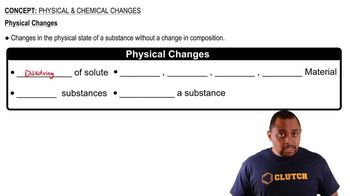Classify each change as physical or chemical. a. Natural gas burns in a stove. b. The liquid propane in a gas grill evaporates because the valve was left open. c. The liquid propane in a gas grill burns in a flame. d. A bicycle frame rusts on repeated exposure to air and water.
Ch.1 - Matter, Measurement & Problem Solving
Chapter 1, Problem 50
Based on the molecular diagram, classify each change as physical or chemical.
 Verified step by step guidance
Verified step by step guidance1
Identify the initial and final states of the molecules in the diagram.
Determine if there is a change in the chemical composition of the molecules. A change in chemical composition indicates a chemical change.
Look for changes in the arrangement of atoms within the molecules. If atoms are rearranged to form new substances, it is a chemical change.
Check for changes in the physical state (solid, liquid, gas) without altering the chemical identity. Such changes are physical changes.
Classify each change based on your observations: if the chemical identity remains the same, it is a physical change; if new substances are formed, it is a chemical change.

Verified video answer for a similar problem:
This video solution was recommended by our tutors as helpful for the problem above.
Video duration:
2mWas this helpful?
Key Concepts
Here are the essential concepts you must grasp in order to answer the question correctly.
Physical Change
A physical change involves a transformation that does not alter the chemical composition of a substance. Examples include changes in state (like melting or boiling), shape, or size. During a physical change, the molecules remain intact, and no new substances are formed.
Recommended video:
Guided course

Physical Changes
Chemical Change
A chemical change results in the formation of one or more new substances with different chemical properties. This process often involves a reaction where bonds between atoms are broken and formed, such as in combustion or rusting. Indicators of a chemical change can include color change, gas production, or temperature change.
Recommended video:
Guided course

Chemical Changes
Molecular Diagram Interpretation
Interpreting a molecular diagram requires understanding the arrangement and types of atoms involved in a substance. This visual representation helps identify whether changes in the diagram indicate a physical alteration (like a change in state) or a chemical reaction (where new bonds form). Recognizing these changes is crucial for classifying them accurately.
Recommended video:
Guided course

Molecular Orbital Diagram
Related Practice
Textbook Question
19
views
1
rank
Textbook Question
Classify each change as physical or chemical. a. Sugar burns when heated in a skillet. b. Sugar dissolves in water. c. A platinum ring becomes dull because of continued abrasion. d. A silver surface becomes tarnished after exposure to air for a long period of time.
3
views
Textbook Question
Based on the molecular diagram, classify each change as physical or chemical.
24
views
1
rank
Textbook Question
Convert each temperature. a. 32 °F to °C (temperature at which water freezes) b. 77 K to °F (temperature of liquid nitrogen) c. -109 °F to °C (temperature of dry ice) d. 98.6 °F to K (body temperature)
5
views
Textbook Question
The warmest temperature ever measured in the United States is 134 °F, recorded on July 10, 1913, in Death Valley, California. Convert that temperature to °C and K.
6
views
